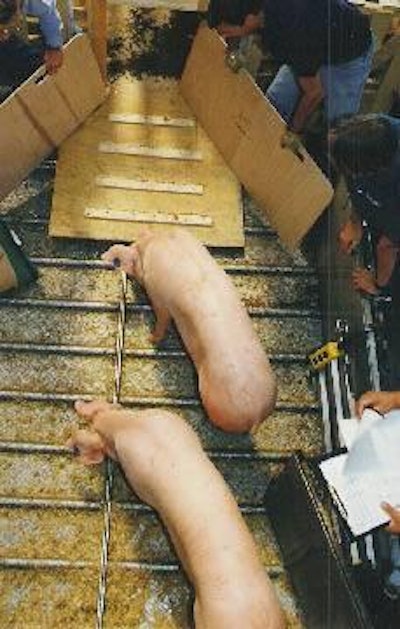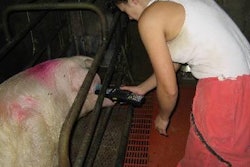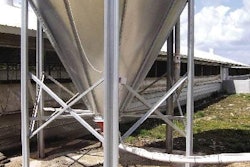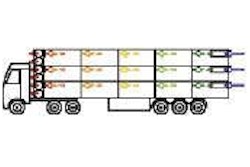
A new regulation on the protection of animals during transport applies across the European Union as from January 2007. It sets out some firm rules on the techniques of loading and transportation for pigs and other farm livestock and also introduces a requirement for animal handlers to be certified as both trained and competent.
Aimed at improving the welfare of animals while transported, this Europe-wide regulation does not apply to farmers transporting their own pigs in their own vehicles for distances of less than 50 kilometres. But any journey over 65km undertaken in connection with an economic activity now needs a so-called transporter authorisation that remains valid for up to 5 years. This comes in 2 forms according to the time spent on the road, either for short runs or for long ones exceeding 8 hours.
All EU member states are incorporating the regulation into their national laws concerning animal transport. Where an economic activity is involved and the journey by road is more than 65 kilometres long, according to the new rules, a certificate of competence becomes mandatory both for the driver of the livestock vehicle and for any attendants assisting the transport process.
While the transportation regulation itself has already taken effect, however, the deadline for obtaining a handler's certification does not arrive until January 2008. After that date the certificate is being awarded to applicants who undergo a training course and have their level of knowledge assessed independently. Training is expected to cover not only the fundamentals of transport conditions, but also the specifics of documentation and journey planning together with some scientific aspects of animal behaviour and physiology. Attendants learn about the impact of driving methods on the welfare of the animal and the quality of its meat. Other elements covered relate to emergency care and to the safety of personnel handling animals.
Unlike the procedures followed in Europe in the past, self assessment by self-employed transporters or certification by employers will no longer be accepted. Certificates will instead be issued by an independent agency designated by the member state. The certificate must afterwards be included with all applications to have long-distance journeys authorised officially as the regulation demands.
To be deemed acceptable for the authorisation, it has to be specific to the role the individual will take, to the length of the journey and to the species to be transported. A theory test may suffice for journeys under 8 hours in duration, but longer transports will necessitate an assessment of practical skills in driving and animal handling.
A journey is defined as the time from when the first pig is put onto the vehicle until the last one is unloaded at the final destination. Everyone who hauls pigs, whatever the journey length, is urged to continue to follow good practice by making sure the trip is planned properly and the time kept to a minimum. Those handling the animals are expected to be trained and competent in the task and must not use violence or any methods likely to cause unnecessary fear, injury or suffering.
There is also renewed emphasis on making sure that the pigs are fit to travel. The regulation states categorically that No animal shall be transported unless it is fit for the intended journey and all animals shall be transported in conditions guaranteed not to cause them injury or unnecessary suffering'. Unfit animals are considered to include the very young, with a particular stipulation of a maximum of 100 kilometres for transporting piglets under 3 weeks old. More generally, the rules on fitness to travel are said to apply regardless of distance, even if the transporter is not required to have vehicle authorisation or training and certificates of competence until the journey exceeds 65 kilometres from place of departure to destination.
Transporter authorisation for road journeys over 8 hours raises the concept that the operator must have the means of contacting the driver at any time, as well as procedures to trace and record the movement of the vehicle and contingency plans in the event of an emergency. There is even a call for all new vehicles to be fitted with a satellite navigation system; this may be extended to older vehicles from the start of 2009, although the European Commission is known to be working on more detailed specifications to take effect before this will apply.
Rules on ramps
Vehicles used for transporting pigs by road need to be designed, constructed, maintained and operated so as to avoid injury and ensure the safety of the animals, says Europe's newly introduced welfare code. This includes a design that is easy to clean and disinfect and the use of anti-slip flooring and reasonable lighting. The regulation also says that loading and unloading facilities must be similarly designed and that sufficient floor area and height are provided for the animals.
In describing practices relating to loading and unloading, it insists that the ramp used to walk pigs onto a vehicle should not be steeper than an angle of 20°, corresponding to 36.4% to the horizontal and equivalent to a vertical rise of 4 over a distance of 11. Since measuring the slope angle of a ramp accurately tends to be difficult, particularly when the vehicle is on uneven ground, a tolerance of plus or minus 5 degrees may be allowed.
Previous legislation has often referred to a maximum gradient of 29° or 4 in 7 for the loading and unloading of farm animals, when the vehicle is on level ground. However, the latest recommendation of not having a slope of more than 20° for pigs is said to be intended to minimise the stress which loading and unloading can cause. The same reasoning is applied in recommending a maximum 20° angle on ramps used for transferring pigs between floors within the vehicle even though the general limit for livestock is put at gradient of 2 in 3 (33°).
Any step at the top or bottom of a ramp must not exceed 21cm, codes add. No gap between the ramp or lifting platform and the vehicle should be so large that an animal's foot could pass into it. The widest acceptable is 6cm.





.jpg?auto=format%2Ccompress&fit=crop&h=167&q=70&w=250)











